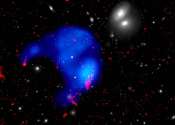'Lonely cloud' bigger than Milky Way found in a galaxy 'no-man's land'
A scientifically mysterious, isolated cloud bigger than the Milky Way has been found by a research team at The University of Alabama in Huntsville (UAH) in a "no-man's land" for galaxies.









